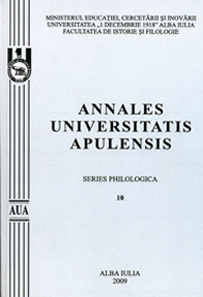COHESIVE RELATION OF ELLIPSIS IN ENGLISH
COHESIVE RELATION OF ELLIPSIS IN ENGLISH
Author(s): Vera Vujević ĐurićSubject(s): Language and Literature Studies
Published by: Universitatea »1 Decembrie 1918« Alba Iulia
Keywords: ellipsis; omission; phrase; clause; cohesion; context
Summary/Abstract: Ellipsis has been a major topic in linguistics ever since the first formal analyses of languages were introduced. This is partly because its behaviour and constraints on its use suggest the presence of hidden structures and the need to theorise on how this silence should be interpreted. This paper attempts to provide an insight into the resourceful examples of ellipsis in the contemporary English language. Ellipsis is the grammatical omission of a language element for reasons associated with clarity and emphasis, where it enables attention to be focused on new and important information: ‘Ellipsis is highly characteristic of spontaneous speech, because of the need to reduce syntactic complexity due to real time pressures. In addition, speakers respond to the impulse to speed up communication, avoiding the tedium of unnecessary repetition’ (Biber et al. 2002:441). The omitted elements can usually be recovered by considering the linguistic context. In the strict application of the term, ellipsis requires verbatim recoverability; that is, the actual deleted word(s) must be precisely recoverable. Therefore, with textual ellipsis recoverability of the full structure depends on what has been said or written before or after in the linguistic context. Modern communication today involves and requires fast spread of information and therefore economizing with language structures. Ellipsis, in this sense, represents a rather useful and interesting language mechanism and cohesive device for achieving economy by avoiding repetition. In this paper we will try and provide an explicated analysis of ellipsis in phrases and clauses in the language of British newspapers with a particular accent on the ellipsis as a cohesive device in the text, since, as we have already stressed out, language does not function in isolation but in concrete situations of use. Ellipsis, as a widespread linguistic phenomenon, has long been the topic of a heated discussion in the linguistics literature. Linguistic research has contributed significantly to our understanding of the different types of ellipses, as interface phenomena between syntax, semantics, and information structure. This paper, too, is an attempt to show one aspect of it; however, many aspects of how the different components work together still remain to be worked out.
Journal: Annales Universitatis Apulensis. Series Philologica
- Issue Year: 11/2010
- Issue No: 3
- Page Range: 132-143
- Page Count: 12
- Language: English

